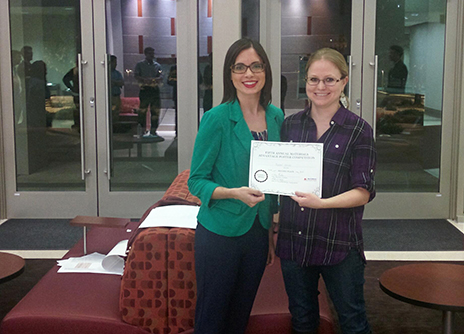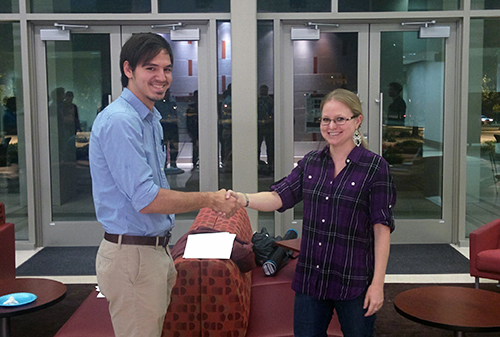 Two students from the Department of Biomedical Engineering at Texas A&M University are among the top winners at the 5th Annual Student Research Poster Competition, sponsored by the university chapter of Material Advantage.
Two students from the Department of Biomedical Engineering at Texas A&M University are among the top winners at the 5th Annual Student Research Poster Competition, sponsored by the university chapter of Material Advantage.
Rachel Unruh, a graduate student advised by Professor Michael McShane, and Jonathan Griffin, an undergraduate student working in the laboratory of Assistant Professor Akhilesh Gaharwar, each were recognized for posters detailing their research. Unruh placed second in the graduate category, and Griffin was recognized in the undergraduate category of the competition.
Material Advantage is a student program specifically created for undergraduate and graduate students enrolled in materials science, engineering and other technical engineering programs at universities around the world. The program provides students access to four materials science and engineering professional societies – The American Ceramic Society, Association for Iron & Steel Technology, ASM International, and The Minerals, Metals and Materials Society.
Unruh’s research focuses on the development of optical glucose sensors for diabetes management. These hydrogel-based sensors are designed for subcutaneous implantation, providing a minimally invasive way to measure biomolecules through a single injection versus standard fingerprick methods. Her poster, "Evaluation of Luminescent Copolymer Hydrogels as Fully-Implantable Sensors," addressed her efforts in exploring the performance of these glucose sensors on the benchtop and in preclinical studies.
 Griffin is investigating the use of nanoparticles for control cell adhesion in regenerative medicine. Controlling cell adhesion on a biomaterial surface is associated with the long-term efficacy of an implanted material, Gaharwar notes. Griffin’s poster, “Hydrogels from Poly (ethylene glycol) Reinforced with Aluminium Oxide Nanoparticles,” detailed how low concentrations of aluminium oxide nanoparticles interact with polymeric hydrogels and can modulate cell adhesion characteristics. His study suggests that the ability to regulate cellular attachment to the biomaterial surfaces can be tailored toward the specific requirements of a biomedical application.
Griffin is investigating the use of nanoparticles for control cell adhesion in regenerative medicine. Controlling cell adhesion on a biomaterial surface is associated with the long-term efficacy of an implanted material, Gaharwar notes. Griffin’s poster, “Hydrogels from Poly (ethylene glycol) Reinforced with Aluminium Oxide Nanoparticles,” detailed how low concentrations of aluminium oxide nanoparticles interact with polymeric hydrogels and can modulate cell adhesion characteristics. His study suggests that the ability to regulate cellular attachment to the biomaterial surfaces can be tailored toward the specific requirements of a biomedical application.
About the Department of Biomedical Engineering
Committed to solving the world’s greatest health problems through the exploration of new ideas, integrated research and innovation, the Department of Biomedical Engineering at Texas A&M is producing the next generation of biomedical engineers, developing new technologies and new jobs, and achieving revolutionary advancements for the future of health care. The department has unique strengths in regenerative engineering, medical augmentation, molecular diagnostics/theranostics, tele-health, and precision medicine, and its faculty members are internationally recognized with collaborative relationships that span engineering, physical and natural sciences, medicine and veterinary sciences.